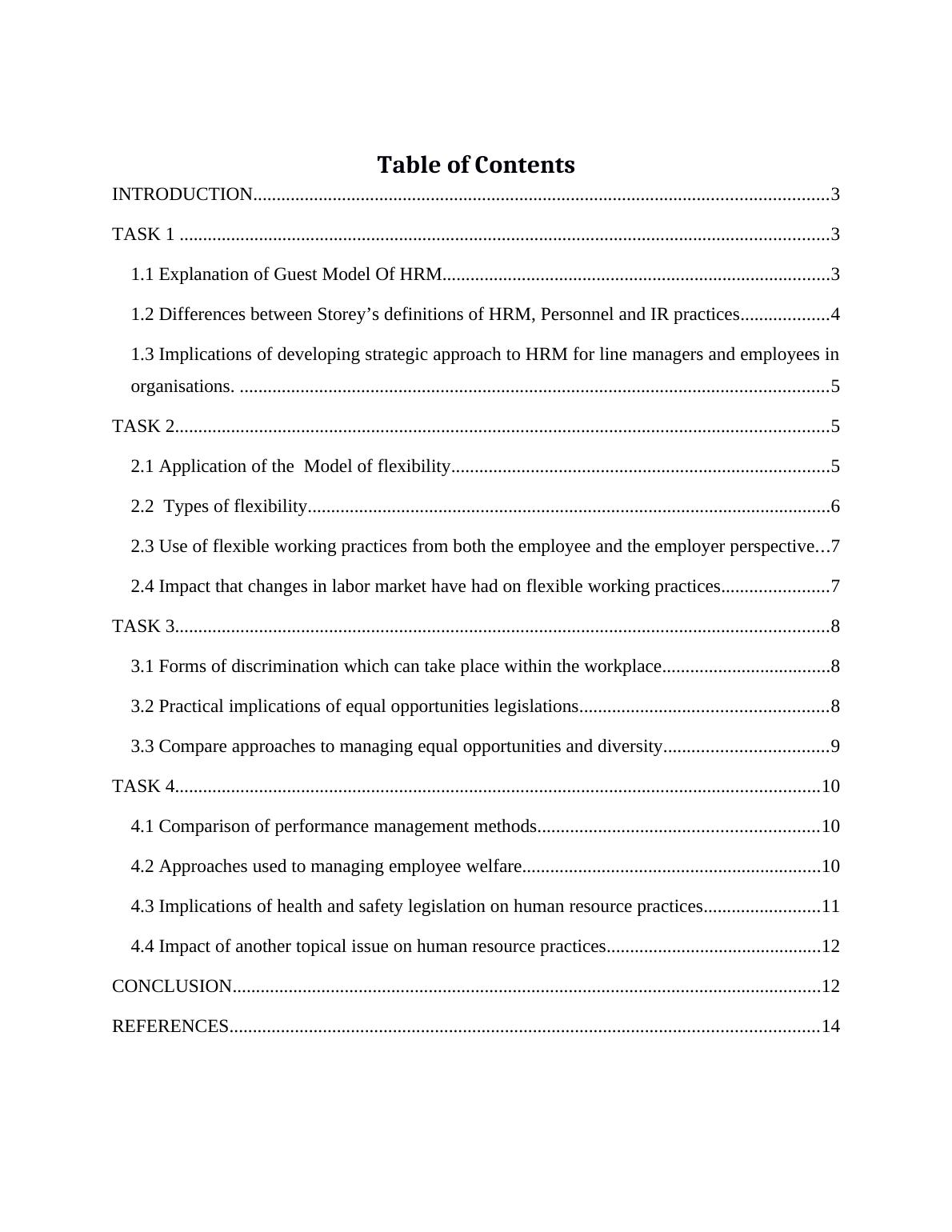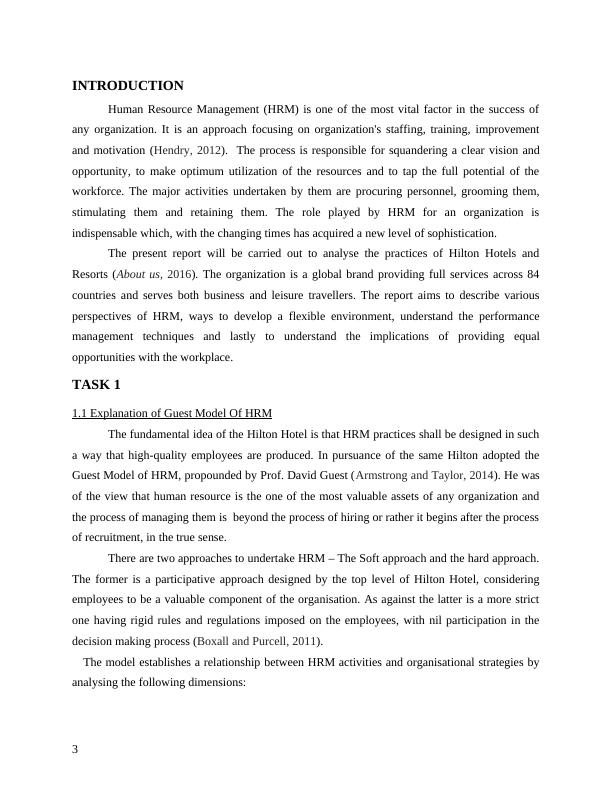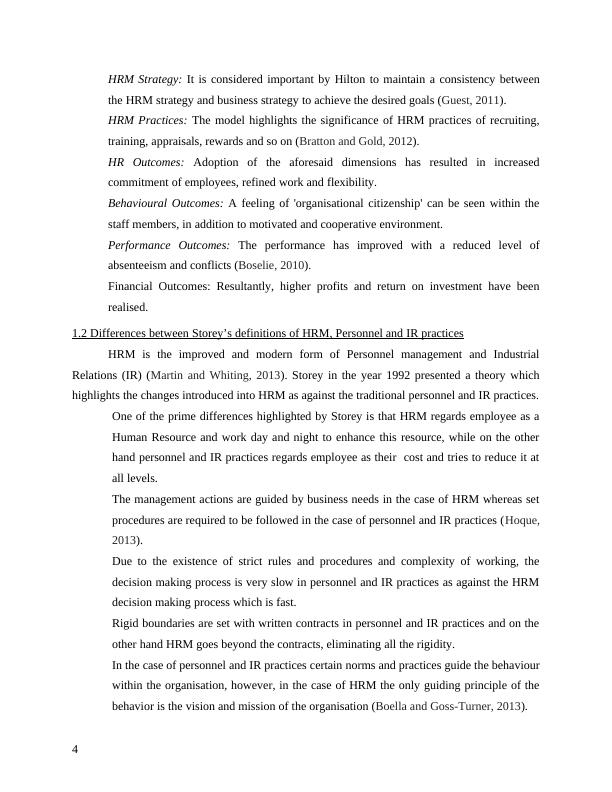Practices of Hilton Hotels and Resorts | Report
15 Pages5173 Words31 Views
Added on 2020-02-05
Practices of Hilton Hotels and Resorts | Report
Added on 2020-02-05
ShareRelated Documents
MANAGING HUMAN RESOURCE

Table of Contents
INTRODUCTION...........................................................................................................................3
TASK 1 ...........................................................................................................................................3
1.1 Explanation of Guest Model Of HRM...................................................................................3
1.2 Differences between Storey’s definitions of HRM, Personnel and IR practices...................4
1.3 Implications of developing strategic approach to HRM for line managers and employees in
organisations. ..............................................................................................................................5
TASK 2............................................................................................................................................5
2.1 Application of the Model of flexibility.................................................................................5
2.2 Types of flexibility................................................................................................................6
2.3 Use of flexible working practices from both the employee and the employer perspective...7
2.4 Impact that changes in labor market have had on flexible working practices.......................7
TASK 3............................................................................................................................................8
3.1 Forms of discrimination which can take place within the workplace....................................8
3.2 Practical implications of equal opportunities legislations.....................................................8
3.3 Compare approaches to managing equal opportunities and diversity...................................9
TASK 4..........................................................................................................................................10
4.1 Comparison of performance management methods............................................................10
4.2 Approaches used to managing employee welfare................................................................10
4.3 Implications of health and safety legislation on human resource practices.........................11
4.4 Impact of another topical issue on human resource practices..............................................12
CONCLUSION..............................................................................................................................12
REFERENCES..............................................................................................................................14
INTRODUCTION...........................................................................................................................3
TASK 1 ...........................................................................................................................................3
1.1 Explanation of Guest Model Of HRM...................................................................................3
1.2 Differences between Storey’s definitions of HRM, Personnel and IR practices...................4
1.3 Implications of developing strategic approach to HRM for line managers and employees in
organisations. ..............................................................................................................................5
TASK 2............................................................................................................................................5
2.1 Application of the Model of flexibility.................................................................................5
2.2 Types of flexibility................................................................................................................6
2.3 Use of flexible working practices from both the employee and the employer perspective...7
2.4 Impact that changes in labor market have had on flexible working practices.......................7
TASK 3............................................................................................................................................8
3.1 Forms of discrimination which can take place within the workplace....................................8
3.2 Practical implications of equal opportunities legislations.....................................................8
3.3 Compare approaches to managing equal opportunities and diversity...................................9
TASK 4..........................................................................................................................................10
4.1 Comparison of performance management methods............................................................10
4.2 Approaches used to managing employee welfare................................................................10
4.3 Implications of health and safety legislation on human resource practices.........................11
4.4 Impact of another topical issue on human resource practices..............................................12
CONCLUSION..............................................................................................................................12
REFERENCES..............................................................................................................................14

INTRODUCTION
Human Resource Management (HRM) is one of the most vital factor in the success of
any organization. It is an approach focusing on organization's staffing, training, improvement
and motivation (Hendry, 2012). The process is responsible for squandering a clear vision and
opportunity, to make optimum utilization of the resources and to tap the full potential of the
workforce. The major activities undertaken by them are procuring personnel, grooming them,
stimulating them and retaining them. The role played by HRM for an organization is
indispensable which, with the changing times has acquired a new level of sophistication.
The present report will be carried out to analyse the practices of Hilton Hotels and
Resorts (About us, 2016). The organization is a global brand providing full services across 84
countries and serves both business and leisure travellers. The report aims to describe various
perspectives of HRM, ways to develop a flexible environment, understand the performance
management techniques and lastly to understand the implications of providing equal
opportunities with the workplace.
TASK 1
1.1 Explanation of Guest Model Of HRM
The fundamental idea of the Hilton Hotel is that HRM practices shall be designed in such
a way that high-quality employees are produced. In pursuance of the same Hilton adopted the
Guest Model of HRM, propounded by Prof. David Guest (Armstrong and Taylor, 2014). He was
of the view that human resource is the one of the most valuable assets of any organization and
the process of managing them is beyond the process of hiring or rather it begins after the process
of recruitment, in the true sense.
There are two approaches to undertake HRM – The Soft approach and the hard approach.
The former is a participative approach designed by the top level of Hilton Hotel, considering
employees to be a valuable component of the organisation. As against the latter is a more strict
one having rigid rules and regulations imposed on the employees, with nil participation in the
decision making process (Boxall and Purcell, 2011).
The model establishes a relationship between HRM activities and organisational strategies by
analysing the following dimensions:
3
Human Resource Management (HRM) is one of the most vital factor in the success of
any organization. It is an approach focusing on organization's staffing, training, improvement
and motivation (Hendry, 2012). The process is responsible for squandering a clear vision and
opportunity, to make optimum utilization of the resources and to tap the full potential of the
workforce. The major activities undertaken by them are procuring personnel, grooming them,
stimulating them and retaining them. The role played by HRM for an organization is
indispensable which, with the changing times has acquired a new level of sophistication.
The present report will be carried out to analyse the practices of Hilton Hotels and
Resorts (About us, 2016). The organization is a global brand providing full services across 84
countries and serves both business and leisure travellers. The report aims to describe various
perspectives of HRM, ways to develop a flexible environment, understand the performance
management techniques and lastly to understand the implications of providing equal
opportunities with the workplace.
TASK 1
1.1 Explanation of Guest Model Of HRM
The fundamental idea of the Hilton Hotel is that HRM practices shall be designed in such
a way that high-quality employees are produced. In pursuance of the same Hilton adopted the
Guest Model of HRM, propounded by Prof. David Guest (Armstrong and Taylor, 2014). He was
of the view that human resource is the one of the most valuable assets of any organization and
the process of managing them is beyond the process of hiring or rather it begins after the process
of recruitment, in the true sense.
There are two approaches to undertake HRM – The Soft approach and the hard approach.
The former is a participative approach designed by the top level of Hilton Hotel, considering
employees to be a valuable component of the organisation. As against the latter is a more strict
one having rigid rules and regulations imposed on the employees, with nil participation in the
decision making process (Boxall and Purcell, 2011).
The model establishes a relationship between HRM activities and organisational strategies by
analysing the following dimensions:
3

HRM Strategy: It is considered important by Hilton to maintain a consistency between
the HRM strategy and business strategy to achieve the desired goals (Guest, 2011). HRM Practices: The model highlights the significance of HRM practices of recruiting,
training, appraisals, rewards and so on (Bratton and Gold, 2012). HR Outcomes: Adoption of the aforesaid dimensions has resulted in increased
commitment of employees, refined work and flexibility. Behavioural Outcomes: A feeling of 'organisational citizenship' can be seen within the
staff members, in addition to motivated and cooperative environment.
Performance Outcomes: The performance has improved with a reduced level of
absenteeism and conflicts (Boselie, 2010).
Financial Outcomes: Resultantly, higher profits and return on investment have been
realised.
1.2 Differences between Storey’s definitions of HRM, Personnel and IR practices
HRM is the improved and modern form of Personnel management and Industrial
Relations (IR) (Martin and Whiting, 2013). Storey in the year 1992 presented a theory which
highlights the changes introduced into HRM as against the traditional personnel and IR practices.
One of the prime differences highlighted by Storey is that HRM regards employee as a
Human Resource and work day and night to enhance this resource, while on the other
hand personnel and IR practices regards employee as their cost and tries to reduce it at
all levels.
The management actions are guided by business needs in the case of HRM whereas set
procedures are required to be followed in the case of personnel and IR practices (Hoque,
2013).
Due to the existence of strict rules and procedures and complexity of working, the
decision making process is very slow in personnel and IR practices as against the HRM
decision making process which is fast.
Rigid boundaries are set with written contracts in personnel and IR practices and on the
other hand HRM goes beyond the contracts, eliminating all the rigidity.
In the case of personnel and IR practices certain norms and practices guide the behaviour
within the organisation, however, in the case of HRM the only guiding principle of the
behavior is the vision and mission of the organisation (Boella and Goss-Turner, 2013).
4
the HRM strategy and business strategy to achieve the desired goals (Guest, 2011). HRM Practices: The model highlights the significance of HRM practices of recruiting,
training, appraisals, rewards and so on (Bratton and Gold, 2012). HR Outcomes: Adoption of the aforesaid dimensions has resulted in increased
commitment of employees, refined work and flexibility. Behavioural Outcomes: A feeling of 'organisational citizenship' can be seen within the
staff members, in addition to motivated and cooperative environment.
Performance Outcomes: The performance has improved with a reduced level of
absenteeism and conflicts (Boselie, 2010).
Financial Outcomes: Resultantly, higher profits and return on investment have been
realised.
1.2 Differences between Storey’s definitions of HRM, Personnel and IR practices
HRM is the improved and modern form of Personnel management and Industrial
Relations (IR) (Martin and Whiting, 2013). Storey in the year 1992 presented a theory which
highlights the changes introduced into HRM as against the traditional personnel and IR practices.
One of the prime differences highlighted by Storey is that HRM regards employee as a
Human Resource and work day and night to enhance this resource, while on the other
hand personnel and IR practices regards employee as their cost and tries to reduce it at
all levels.
The management actions are guided by business needs in the case of HRM whereas set
procedures are required to be followed in the case of personnel and IR practices (Hoque,
2013).
Due to the existence of strict rules and procedures and complexity of working, the
decision making process is very slow in personnel and IR practices as against the HRM
decision making process which is fast.
Rigid boundaries are set with written contracts in personnel and IR practices and on the
other hand HRM goes beyond the contracts, eliminating all the rigidity.
In the case of personnel and IR practices certain norms and practices guide the behaviour
within the organisation, however, in the case of HRM the only guiding principle of the
behavior is the vision and mission of the organisation (Boella and Goss-Turner, 2013).
4

End of preview
Want to access all the pages? Upload your documents or become a member.
Related Documents
Managing Human Resource : Hilton Hotellg...
|18
|5874
|50
Human Resource Management Assignment - Hilton Hotellg...
|16
|5365
|262
Report On Hilton Hotel- Aspects Of Managing Human Resourceslg...
|17
|5279
|98
Human Resource Management Report - Marriott Internationallg...
|19
|6045
|1051
Report on Managing Human Resource Management - Ascari Carslg...
|21
|6949
|140
Human Resource Management Assignment | Legal & Regulatory Framework Impactslg...
|17
|5809
|915
